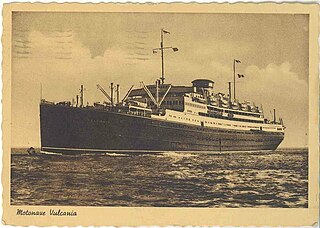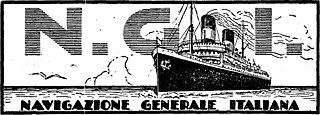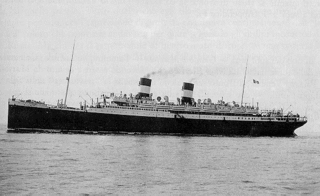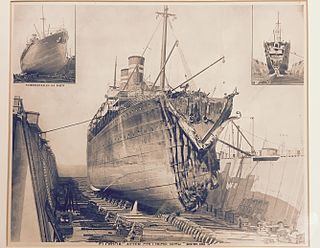
The Florio family was a prominent entrepreneurial Italian family who started many lucrative activities in Sicily involving the export of Sicilian products in the 19th century, in some ways redeeming Sicily from feudal immobility. The family extended its interests to shipping, shipbuilding, fisheries, mining, metallurgy and ceramics. The Florio economic dynasty was one of the wealthiest Italian families during the late 19th century. In the heyday of the Florio business empire reportedly some 16,000 people depended on the family, and the press sometimes referred to Palermo as 'Floriopolis'.
Known as Italian Line and from 1992 Italia Line, whose official name was Italia di Navigazione S.p.A., was a passenger shipping line that operated regular transatlantic services between Italy and the United States, and Italy and South America. During the late 1960s the company turned to running cruises, and from 1981 it became a global freight operator.

Lloyd Triestino was a major shipping company, created in 1919 when the city of Trieste became part of Italy in the settlement after the First World War. It ran passenger services on ocean liners around the world. Seriously harmed by Second World War, in which it lost 68 ships, it recovered to run passenger services with new ships on routes as far as Australia. In 2006, with the business by then mainly container freight, the company's name was changed to Italia Marittima.

The MS Vulcania was an Italian ocean liner built by Cantiere Navale Triestino, Monfalcone, northern Italy, in 1926 for the Italian company, Cosulich Line.

SS Giulio Cesare was a liner of the Navigazione Generale Italiana, which was later operated by the Italian Line. The ship was used to transport first class, second class, and tourist-class passengers.

SS Conte Biancamano was an Italian ocean liner launched in 1925. The name was chosen in honor of Humbert I Biancamano, founder of the Savoy dynasty. She was built in the Scottish shipyard William Beardmore & Co. in Dalmuir, near Glasgow. She was built for the Genovese shipping company Lloyd Sabaudo, operator of Conte Rosso and Conte Verde. The engine, equipped with two steam turbines double reduction unit and two propellers, allowed her to reach a speed of 20 knots, and vented in two funnels. She housed 180 passengers in first class, 220 in second class, 390 in economic class and 2,660 in third class.

The Lloyd Sabaudo was a Shipping transport line formed in Turin in 1906. It began passenger service in 1907, expanding to link Italy to ports in Asia as well as North and South America. In 1932 it merged with several other Italian shipping lines to form the Italian Line.

Navigazione Generale Italiana (NGI) was an Italian shipping company.

MS Augustus was a combined ocean liner and cruise ship built in 1926 for the Navigazione Generale Italiana (NGI). Augustus operated mostly on the Europe to South and North America routes, on the former being one of, if not the largest and fastest liner to sail on regular crossings.

SS Roma was an ocean liner built for the Italian shipping company Navigazione Generale Italiana of Genoa by Ansaldo shipyard in Sestri Ponente. She was the sister ship to MS Augustus. The ship was later transferred to the new Italian Line after the merger of Navigazione Generale Italiana. When Second World War broke out, she was acquired by the Navy for Conversion to aircraft carrier name Aquila. She was taken over by the National Republican Navy of the Italian Social Republic and German occupation forces in 1943, but was partially sunk in 1945 by a commando attack of Mariassalto, an Italian royalist assault unit of the Co-Belligerent Navy of the Kingdom of Italy, made up by members of the former Decima Flottiglia MAS. Roma was raised and scrapped by 1952.
Sparviero was an Italian aircraft carrier designed and built during World War II of the Regia Marina. She was originally the ocean liner MS Augustus built in 1926 for Navigazione Generale Italiana, but was transferred to the new Italian Line after the merger of Navigazione Generale Italiana with the Lloyd Sabaudo and the Cosulich Line. The conversion was started in 1942 originally under the name Falco but was never completed, and the ship was never delivered to the Regia Marina. She began to be scrapped in 1947, a process completed by 1951.
SS Petrella was a German merchant ship, which was torpedoed and sunk on 8 February 1944, north of Souda Bay, Crete, killing some 2,670 of the Italian POWs aboard.

SS Sirio was an Italian passenger steamer that was wrecked off the eastern Spanish coast on 4 August 1906, causing the deaths of at least two hundred Italian and Spanish emigrants bound for Brazil, Uruguay, and Argentina. The wreck had a profound effect on communities in northern Italy and was remembered in popular songs of the era. It was the second worst peacetime maritime disaster in Italian history, only surpassed by the sinking of the Principessa Mafalda nineteen years later.
SS Sud America was an Italian ocean liner. She was built by Wigham Richardson, in Newcastle upon Tyne, England, and launched in 1872. She was operated by Lavarello Fratelli Fu G. B from 1872 until 1883. Her second owner was another Italian shipping company, La Veloce Navigazione Italiana a Vapore S. A., from 1884, who renamed her SS Sud America I.
SS Verona was a transatlantic ocean liner that was built in Ireland in 1908 for an Italian shipping line. She was a troop ship in the Italo-Turkish War of 1911–12 and in the First World War in 1917–18. In 1918 a German submarine sank her in the Mediterranean with great loss of life.
SS Bosnia was an Italian cargo liner built in the 1890s that was shelled and sunk by a German submarine in the Mediterranean during World War I.

Ebe is a former training ship of the Italian Navy. Initially a merchant vessel named San Giorgio, she was acquired by the Navy and used to train non-commissioned officers between 1952 and 1958. Since 1963 she has been preserved and exhibited at the Museo Nazionale Scienza e Tecnologia Leonardo da Vinci in Milan.

MS La Superba is a cruiseferry owned and operated by the Italian ferry company Grandi Navi Veloci. It was built at Nuovi Cantieri Apuania in Marina di Carrara, Italy. When it entered service, La Superba was the largest passenger ferry operating in the Mediterranean, and one of the largest in the world; joined in the following year by the sistership La Suprema, it was surpassed in 2008 by Cruise Roma of Grimaldi Ferries. Its building costed about 120 million dollars.

SS Florida was an Italian ocean liner, built in 1905 for Lloyd Italiano, which operated between Italy and both North and South America. In 1909 she collided with, and sank, White Star Line's Republic off the American coast. Later, as Cavour with Transatlantica Italiana, she was sunk by collision with the Italian auxiliary cruiser Caprera off the Spanish Mediterranean coast on 12 December 1917, without loss of life.

Count Pasquale Leonardi Cattolica was an Italian admiral and politician. He was Minister of the Navy of the Kingdom of Italy during the Italo-Turkish War.















